I’ll confess I don’t pay a lot of attention to gulls but when the brine flies are out their feeding antics can be both interesting and entertaining.
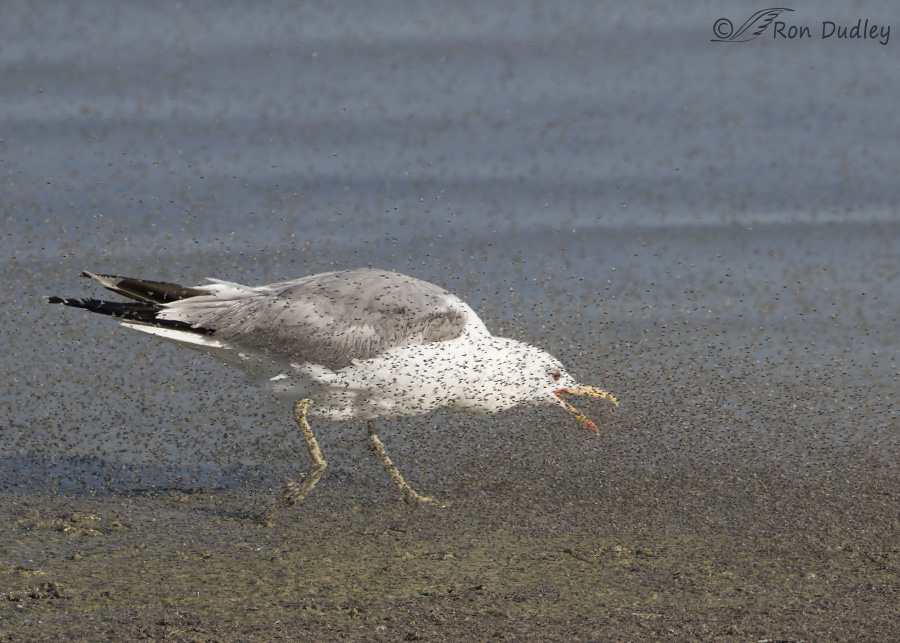
1/1250, f/6.3, ISO 320, Canon 7D, Canon EF 500mm f/4L IS II USM + 1.4 tc, not baited, set up or called in
This time of year brine fly numbers on the shore of the Great Salt Lake are almost unimaginable. I photographed this California Gull five days ago along the causeway to Antelope Island as it took advantage of this enormous Dipteran bounty. The flies were so thick that I had difficulties focusing on the bird.
Different gull species have varying feeding strategies. California Gulls walk slowly along the shoreline until they find a spot on the sand/mud where the flies are particularly thick. Then they run headlong through that thick patch of flies which scares them a few inches into the air and the gull grabs great gobs of them in its open beak and swallows them. When the uneaten flies settle back down onto the mud…
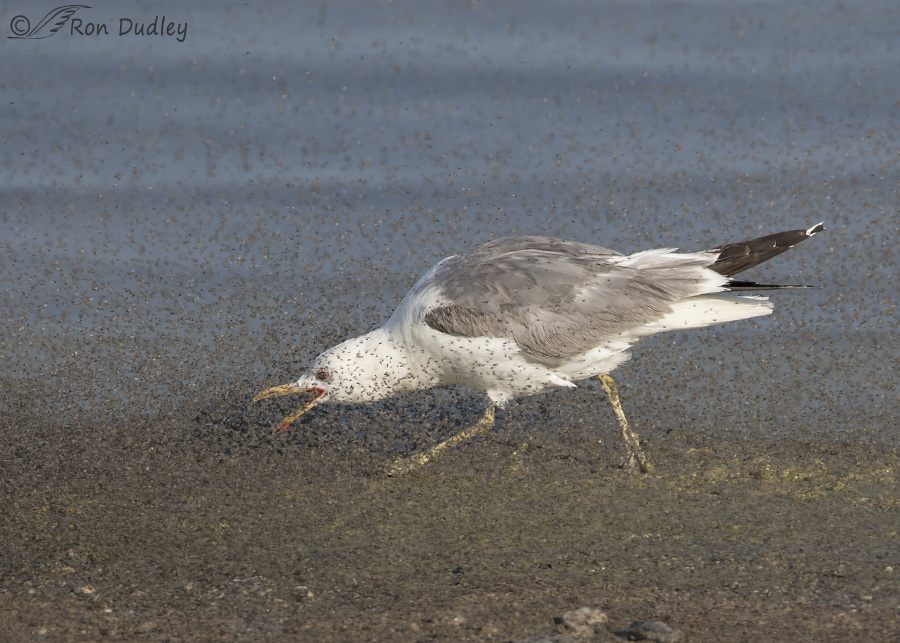
1/1600, f/6.3, ISO 320, Canon 7D, Canon EF 500mm f/4L IS II USM + 1.4 tc, not baited, set up or called in
the gull often turns around and runs through them again.
Eventually the gulls become so satiated that they can hardly move. Flying is a lot of work especially when they’re that full so they typically just hang around in the same fly-rich area and wait until they can force themselves to do it all over again.
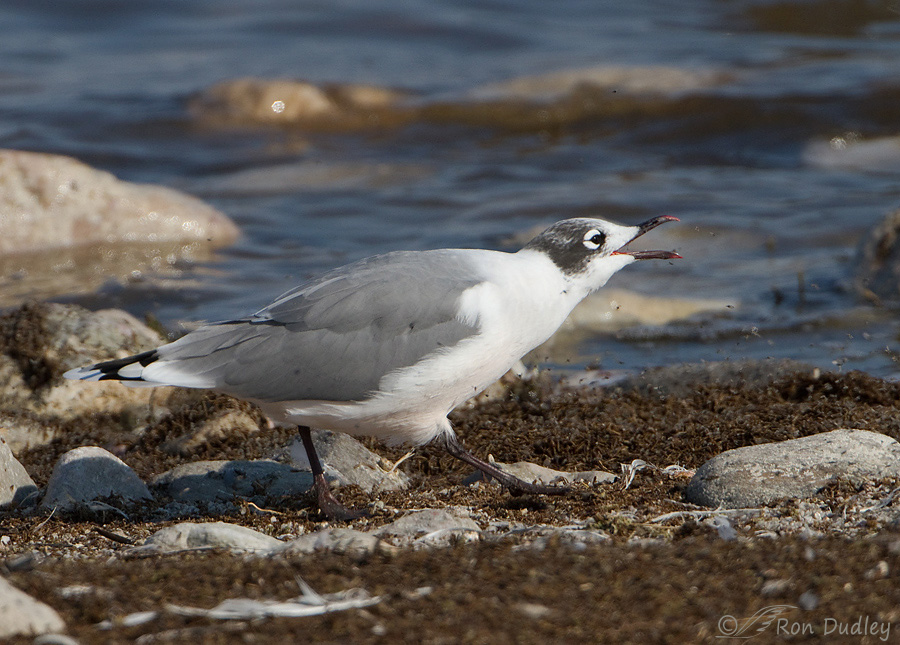
1/1250, f/6.3, ISO 320, Canon 7D, Canon EF 500mm f/4L IS II USM + 1.4 tc, not baited, set up or called in
But Franklin’s Gulls use a completely different feeding strategy. They just stand in one place (this one looks like it’s running but it isn’t) and snag the occasional fly or two out of the air (here you can see several flies in front of its open beak). This method provides less food at a time but it also requires less energy. I’ve never seen this species run after flies.
The dark masses you see on the ground are brine fly pupae casings. They can be this thick (or thicker) for miles along the shoreline.
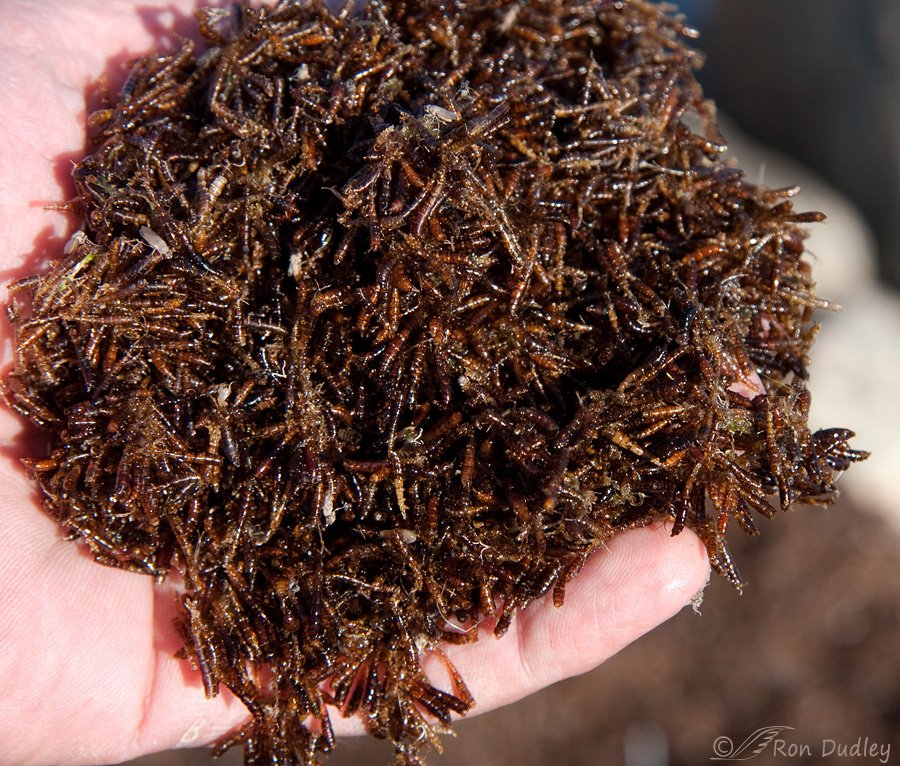
A few years ago I scooped a handful of them up and photographed them. They’re extremely light in weight and great rafts of them can often be seen floating out on the lake.
But birds aren’t the only denizens of Antelope Island to feast on brine flies.
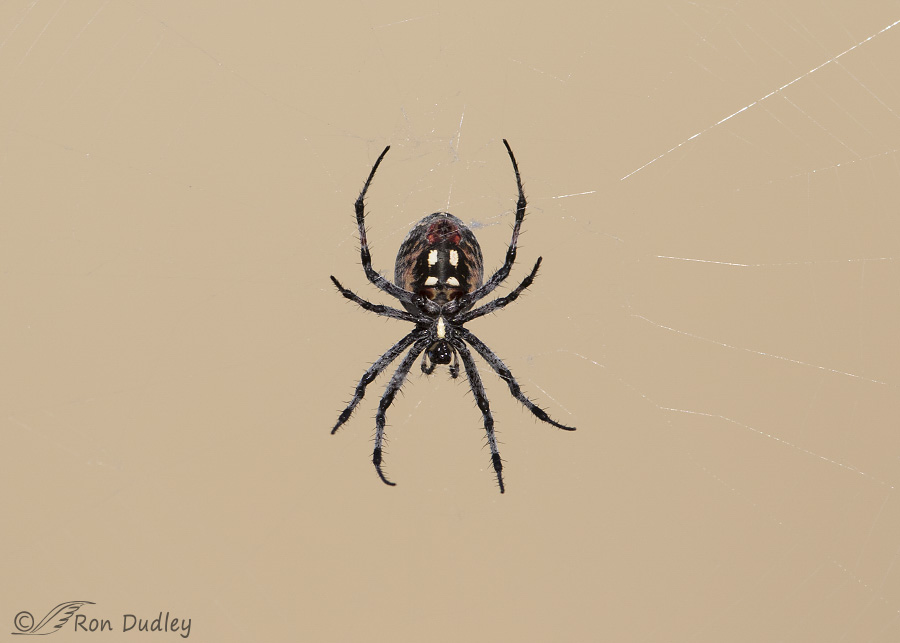
1/1600, f/7.1, ISO 250, Canon 7D Mark II, Canon EF 500mm f/4L IS II USM + 1.4 tc, not baited, set up or called in
Spiders love them too and Antelope Island is known for enormous numbers of spiders, especially in late July and August. I photographed this Western Spotted Orb Weaver a few days ago but the island also has wolf spiders, cat spiders, jumping spiders and the occasional black widow – and they all feed on brine flies. As you drive the roads on the island you can see their large webs stretched between sagebrush plants, especially near the shore where brine flies and midges are thick.
Antelope Island State Park even holds an annual Spider Fest and coincidentally that festival occurs later today.
I’ll end with Robert Kirby. Kirby is an ex-cop turned newspaper columnist and a beloved local legend because he pokes fun at all of our Utah foibles and sacred cows, including Mormons (he is one and often refers to himself as an “OxyMormon”). His humor is dry and delicious.
A few days ago Kirby visited the island for a “dry run” of the Spider Fest and then wrote a column about his experience titled “Yes, I Inhaled The Spider“. As usual it’s an entertaining read and while on the island it sounds like he even discovered a new spider species – the Great Basin Leg-climbing Flesh Ripper!
I love Kirby! I even met him once years ago while we were both doing research at the Utah Historical Society. He won’t remember but I do…
Ron
Note: Just two days after publishing this post I saw (and photographed) a Franklin’s Gull using the same fly-feeding technique used by California Gulls – running after the flies to scare them up and then gulping them down. Go figure!
Perhaps Franklin’s Gulls are learning that dandy move from their larger cousins…?


Very interesting, I had no idea about the gulls and the brine flies. I love the first image as it captures some interesting behavior and the feeling of buzzing insects in amazing numbers Ron. Although gulls are very common, I realized earlier this summer I don’t know much about them. For example, what is their main food source (fish, garbage, etc.)? A friend watched some gulls eat baby Common Merganser chicks in Katmai NP when I was there earlier. I was blown away by that, not realizing they also play the role of a predator. I will read more about them on BNA. Thanks for the education from this great post Ron.
Ed, in my experience many gull species are the epitome of what’s referred to as “opportunistic feeders” – they’ll eat about anything organic they can get down.
I prefer my protein to be vegetable. That many brine flies would do my head in. Ack. And hooray for spiders. I have recently become obsessed with our Peacock Spiders <a href = 'https://www.google.com.au/search?q=peacock+spider+images&client=firefox-b&tbm=isch&tbo=u&source=univ&sa=X&ved=0ahUKEwiboqHv_JvOAhXCFpQKHU16BDEQsAQIHA&biw=1920&bih=969' and think these pictures will show where they get their name. Even my arachnophobi partner warms to them.
Loved the oxymorons article.
Thank you.
Goodness only knows why the link looks like that – but it works. Beautiful things.
Wow, those Peacock Spiders are exceptionally colorful and beautiful, EC!
Ellie Baby! Those spiders are fantastically beautiful!!!!!!!
Aren’t they? Tiny, but so very, very beautiful.
Great interesting shots R0!
Thanks, Charlotte.
Hi Ron,
Great lesson as usual, and great timing – I will be visiting one of my favorite places. Mono Lake, CA in two weeks. It is also known for its brine flies (locals refer to them as alkali flies) and I always enjoy watching the CA Gulls hunting them. Historically, the Mono Lake brine flies and their pupae were an important food source for humans as well. The Kuzedika Paiute Indians relied on fly pupae as one of the staples of their diets. I took my grandson there three years ago and we took a guided walk along the shore – the guide told us that “Kuzedika” means “fly eater”. And, we were offered the opportunity of becoming fly eaters ourselves. Being a good grandpa, and wanting to show my grandson I was adventurous, I accepted a spoonful of the pupae. Not bad, but I recommend lightly salting them first…
Cheers,
Dick
Dick, I knew about the flies at Mono Lake but had never heard that they were a food staple for some tribes. Very interesting. And good for you for getting a mouthful of them down. I would have drawn a line in the sand there, grandson or no grandson…
I LOVED Kirby’s column. Thanks so much for the heads up! I might have to reconsider my destination and come to SLC instead. The Tribune is a great newspaper and these things matter!
Laura, Like many newspapers these days the Trib is having some financial problems but it provides us a perspective that is different from that of our other newspaper.
Re:Kirby: I FOUND HIM! And he’s WONDERFUL!!! I googled him, found some of his articles ( LOVE the one about “the Meaning of Life)…what a treasure!!! Such a delicious, sharp wit and sense of totally irreverant humor…a real gem!!! He should have some mighty pithy things to say about the current political insanity…
You have Kirby pegged, Patty. His commentary is usually about local events and quirks rather than national but when it all gets too much for me Kirby can put a twist on it that entertains me and even helps to calm me down a little…
Not only are there your usual splendid Oh WOW photos in this post but FASCINATING details on behaviors! Just FASCINATING! I love it how Nature seeks a balance–an abundant food source is generally indicative of an abundant source of those who eat it/them!
The brine fly larva look a lot like what I’d call meal worms, which are an excellent food for some birds in rehab (and at feeders).
Just WOW! I so look forward to your posts every morning. You just ROCK! But Patty’s right–you ARE nuts. But that’s not a bad thing 😉
You’re right, Laura, and I get “nutser” every day! Thanks very much.
Yep I did same thing. Kept black widow and fed her flies. But one day she disappeared. I totally freaked out when I found her sitting on my sweater. So that was it!!!! But I have this neat spidar that lives outside will have to send you picture for identification when I get back from vacation.
Ha, bet that experience got your attention, Marina!
The birds and their interesting, unique feeding techniques are wonderful…(so glad they eat so many of those critters)..but, the spider is gorgeous!!! Graceful body, beautiful colers and markings! How big are they?
Patty, they vary in size but some of them, including legs, approach the size of a silver dollar.
I love that you think this spider is “gorgeous” and I agree.
I think I would LOVE Kirby!!! Wish I could read his comments. We need people like him almost as much as we need cleaan water and oxygen..at least I do!
Once again, the behaviors of the different species are fascinating. I’ve never been a fan of spiders, mostly because I don’t enjoy being bitten by the ones that find their way into our house. However, garden spiders, jumping spiders, orb weavers – any of those, when encountered out in the wild are interesting. I like the ones I can walk up to and enjoy without worrying about them crawling on me. Thanks for the good laugh from the Robert Kirby article.
I’m careful of spiders too, Susan, being so only makes sense. But I also enjoy them and appreciate their role in the food web. I once “kept” a black widow in my window well and fed it insects by tossing them into its web. Then I’d get my face very close to the web so I could watch the feeding behavior up close. Fascinating…
That does it! You’re NUTS!!!
There’s no denying the obvious, Patty…
Great pics and great posts. Love the Oxymormon.. Never knew about brine flies until today.
Thank you Ron
Thank you, Sandra. Yes, Kirby knows how to turn a word or a phrase…
What a great post, Ron ! I loved the variety of “dishes” on this menu, and Kirby for dessert–he is truly a Utah treasure, as are YOU.
I loved the way you put that about Kirby, Kris. Thank you.
When I was there two weeks ago, I photographed the gulls and wonered what all the black spots were in my photographs. When I viewed them on the screen, I could tell they were insects, but did not know what kind. Thanks for the info. I also saw hundreds (thousands?) of phalaropes. I wonder if they were feeding on them also. Love your photos.
Doug, many species feed on brine flies on or near the shoreline and I suspect phalaropes are among them.
Wonderful images Ron! Brings back memories of watching similar views in CA or NV, can’t remember which.
Interesting and fun article by Kirby. It took me a long time to get over my dislike for spiders. I just tolerate them long enough to get a picture then walk away, far away! VBG!!
Dick, arachnophobia is an interesting condition. We all know folks who have it to one degree or another and in some it can be extreme.
Great shots! Love the commentary. Even though I spend a considerable amount of time out there, I never really paid much attention to their feeding habits. Thanks for your usual, wonderful observations!
They’re fun to watch, Larry – give it a go before the flies are gone!
Ron:
Time to say thank you. I enjoy your column every day.
Thanks very much, Richard.
Cool photo’s and interesting feeding strategies! 🙂 How do you keep from breathing them?! 🙂 Fun article even if I’m not a huge spider fan. 🙂
Judy, most brine flies stay on or close to the ground so breathing them isn’t a problem. And they’re mostly found right at the shoreline so unless you’re walking there it wouldn’t be an issue anyway.